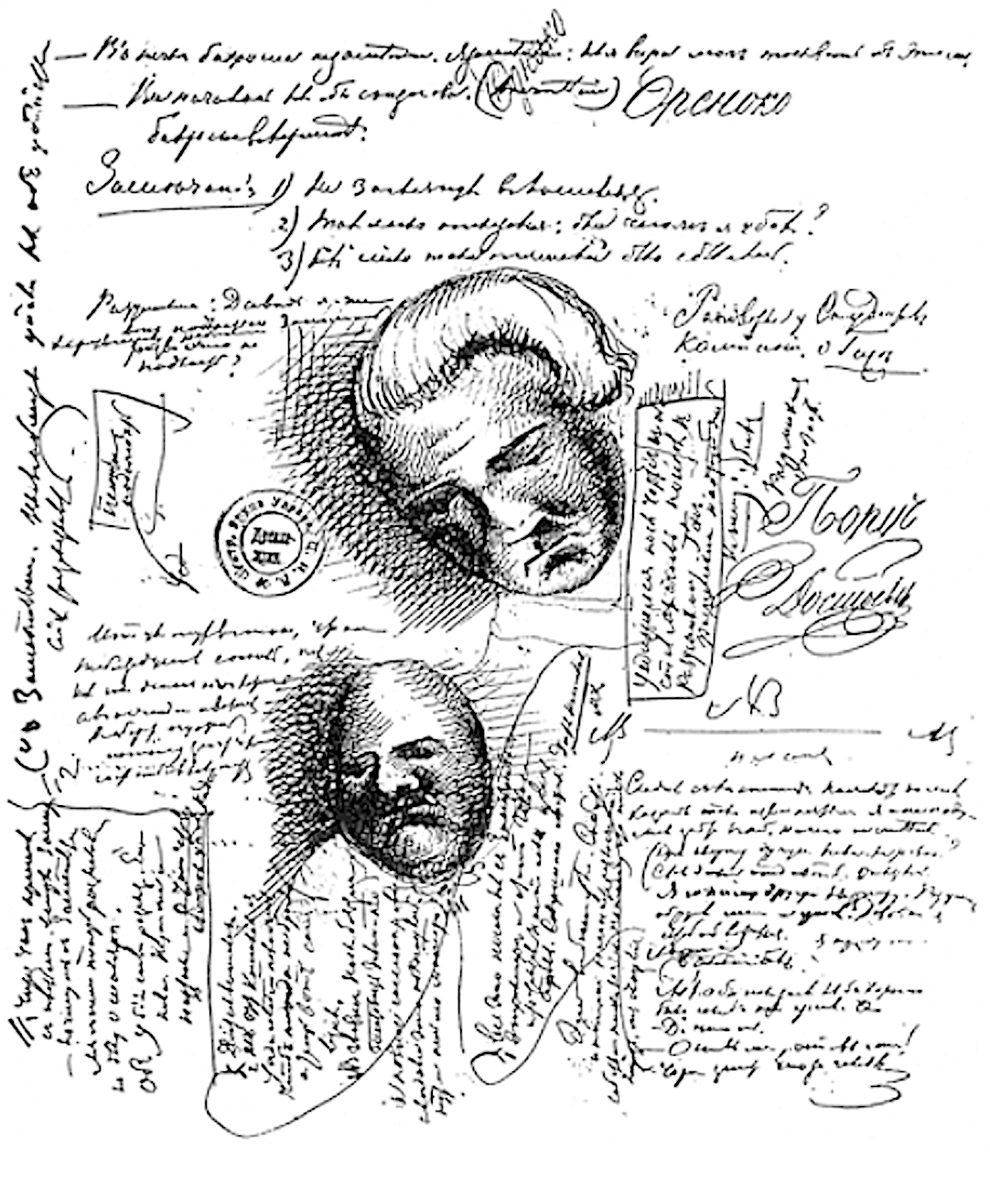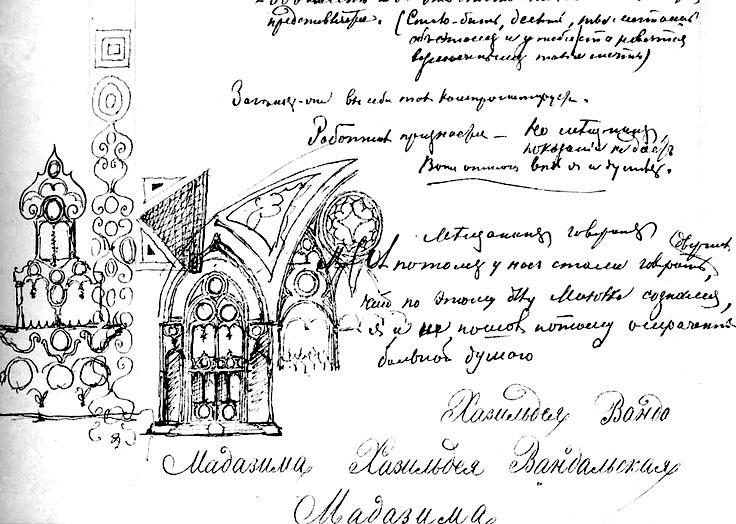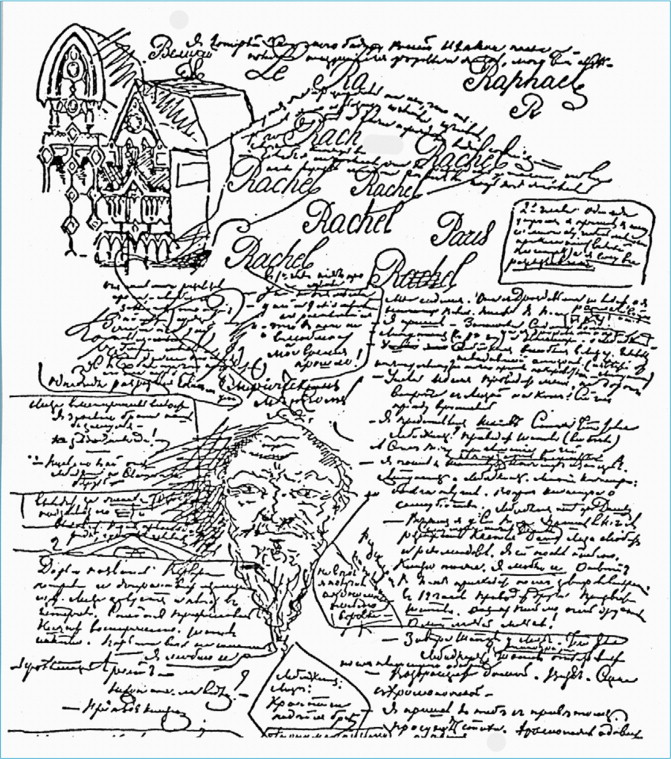
Few would argue against the claim that Fyodor Dostoevsky, author of such bywords for literary weightiness as Crime and Punishment, The Idiot, and The Brothers Karamazov, mastered the novel, even by the formidable standards of 19th-century Russia. But if you look into his papers, you’ll find that he also had an intriguing way with pen and ink outside the realm of letters — or, if you like, deep inside the realm of letters, since to see drawings by Dostoevsky, you actually have to look within the manuscripts of his novels.
Above, we have a page from Crime and Punishment into which a pair of solemn faces (not that their mood will surprise enthusiasts of Russian literature) found their way. Just below, you’ll find examples from the same manuscript of his pen turning toward the ornamental and architectural while he “created his fiction step by step as he lived, read, remembered, reprocessed and wrote,” as the exhibition of “Dostoyevsky’s Doodles” at Columbia University’s Harriman Institute of Russian, Eurasian, and East European Studies put it.

According to the exhibition description, Dostoevsky’s notes to himself “represent that key moment when the accumulated proto-novel crystallized into a text. Like many of us, Dostoevsky doodled hardest when the words came slowest.” Some of Dostoevsky’s character descriptions, argues scholar Konstantin Barsht, “are actually the descriptions of doodled portraits he kept reworking until they were right.” He didn’t just do so during the writing of Crime and Punishment, either; below we have a page of The Devils that combines the human, the architectural, and the calligraphic, apparently the three main avenues through which Dostoevsky pursued the doodler’s art.
Even if you would personally argue against his claim to greatness (and thus side with his countryman, colleague in literature, and fellow part-time artist Vladimir Nabokov, who found him a “mediocre” writer given to “wastelands of literary platitudes”), surely you can enjoy the charge of pure creation you feel from witnessing his textual mind interact with his visual one. Works by Dostoevsky can be found in our Free Audio Books and Free eBooks collections.

Related Content:
Albert Camus Talks About Adapting Dostoyevsky for the Theatre, 1959
Nabokov Makes Editorial Improvements to Kafka’s “The Metamorphosis”
Colin Marshall hosts and produces Notebook on Cities and Culture and writes essays on cities, Asia, film, literature, and aesthetics. He’s at work on a book about Los Angeles, A Los Angeles Primer. Follow him on Twitter at @colinmarshall or on his brand new Facebook page.


The faces in the first image look to me like drawings of death masks.
And it’s intriguing in the third image to see Dostoyevsky doodling in the roman alphabet as he writes out “Le”, “Raphael”, “Bach”, “Rachel”, and “Paris”. It’s tempting to think he was in Paris at the time and, surrounding everywhere by the roman alphabet, decided to give it a go. Though now that I think about it French was commonly spoken and written by the Russian nobility of Dostoyevsky’s day, so perhaps he needed no practice in it at all.
As far as I have read, he dictated much of his work to his wife/secretary, which might be a partial explanation for the doodling, but beautiful…
Reminds me of the Indian poet and Nobel Laureate Rabindra Nath Tagore. He too used to doodle a lot while writing poems and which was the genesis of the brilliant paintings of his later years.
One man’s doodle is another man’s work of art.
Here is a little more on Dostoyevsky:
“Tolstoy and Dostoyevsky“http://hitchhikeamerica.wordpress.com/2012/09/26/tolstoy-and-dostoyevsky-philip-yancey/
Dostoevsky Draws Shakespeare: The Fascinating Discovery
http://www.huffingtonpost.co.uk/annie-martirosyan/dostoevsky-draws-shakespe_b_6327176.html